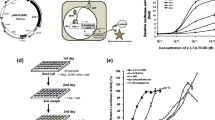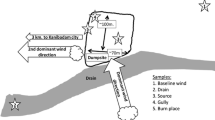Abstract
Estrogen- and dioxin-like responsive element mediated Chemically Activated LUciferine gene eXpression (ERE/DRE-dual CALUX) was utilized to develop dualbioassays for simultaneously determining estrogen and dioxin levels. The devised ERE/DRE-dual CALUX bioassay system, was applied to the analysis of 103 estrogen and dioxin-related isomers, PAHs, PCBs, and pesticides. The nonylphenol highly induced estrogen-like activity (9.95 times) while benzo(k)fluoranthene, chrysene (zonerefined), and 3,3′,4,4′,5-pentachlorobiphenyl, highly induced dioxin-like activity (32.23, 42.39, and 34.47 times) respectively as compared with the untreated control. To confirm the validity of the devised ERE/DRE-dual CALUX bioassay system, we compared this bioassay with high-resolution gas chromatography/high-resolution mass spectrometry (HRGC/HRMS) to assess five air samples taken in Korea. The correlation coefficient between the ERE/DRE-dual CALUX bioassay system and HRGC/HRMS method showed a good relationship (r2 = 0.92). This study indicates that ERE/DRE-dual CALUX is a simple, high-throughput, valid, and inexpensive bioassay method for screening large numbers of environmental samples.
Similar content being viewed by others
References
Diamanti-Kandarakis, E. (2009) Endocrine-disrupting chemicals: An Endocrine society scientific statement. Endocrine Rev. 30: 293–342.
Dickerson, S. M. and A. C. Gore (2007) Estrogenic environmental endocrine-disrupting chemical effects on reproductive neuroendocrine function and dysfunction across the life cycle. Rev. Endocrine and Metabolic Disorders 8: 143–159.
Gore, A. C. and D. Crews (2009) Environmental Endocrine Disruption of Brain and Behavior, in Hormones, Brain and Behavior. pp. 1789–1816. In: W. P. Donald (ed.). Academic Press, San Diego..
Kerkvliet, N. I. (1995) Immunological effects of chlorinated dibenzo-p-dioxins. Environ. Health Perspect. 103: 47–53.
Cole, P. (2003) Dioxin and cancer: A critical review. Regul. Toxicol. Pharmacol. 38: 378–388.
Peterson, R. E., H. M. Theobald, and G. L. Kimmel (1993) Developmental and reproductive toxicity of dioxins and related compounds: Cross-species comparisons. Crit. Rev. Toxicol. 23: 283–335.
Bertazzi, P. A.(1999) Dioxin exposure and human leukemias and lymphomas. Lessons from the Seveso accident and studies on industrial workers. Leukemia 13: 72–74.
Ahmed, S. (2005) Protein kinase Ctheta activity is involved in the 2,3,7,8-tetrachlorodibenzo-p-dioxin-induced signal transduction pathway leading to apoptosis in L-MAT, a human lymphoblastic T-cell line. FEBS J. 272: 903–915.
Couture, L. A., B. D. Abbott, and L. S. Birnbaum (1990) A critical review of the developmental toxicity and teratogenicity of 2,3,7,8-tetrachlorodibenzo-p-dioxin: recent advances toward understanding the mechanism. Teratol. 42: 619–627.
Van den Berg, M. (1998) Toxic equivalency factors (TEFs) for PCBs, PCDDs, PCDFs for humans and wildlife. Environ. Health Perspect. 106: 775–792.
Vanderperren, H. (2004) TEQ-value determinations of animal feed; emphasis on the CALUX bioassay validation. Talanta 63: 1277–1280.
Garrison, P. M. (1996) Species-specific recombinant cell lines as bioassay systems for the detection of 2,3,7,8-tetrachlorodibenzop-dioxin-like chemicals. Fundam. Appl. Toxicol. 30: 194–203.
Yang, C. S., F. S. Strickhart, and L. P. Kicha (1978) Analysis of the aryl hydrocarbon hydroxylase assay. Biochem. Pharmacol. 27: 2321–2326.
Krüner, G. and H. V. Westernhagen (1999) Sources of measurement error in assays of EROD activity of fish for biological effects monitoring. Helgoland Marine Res. 53: 250–256.
Takigami, H. (2008) Chemical and bioassay monitoring of PCB-contaminated soil remediation using solvent extraction technology. J. Environ. Monit. 10: 198–205.
Behnisch, P. A. (2002) Low-temperature thermal decomposition of dioxin-like compounds in fly ash: Combination of chemical analysis with in vitro bioassays (EROD and DR-CALUX). Environ. Sci. Technol. 36: 5211–5217.
Asari, M. (2004) Waste wood recycling as animal bedding and development of bio-monitoring tool using the CALUX assay. Environ. Int. 30: 639–649.
Houtman, C. J. (2004) Toxicological profiling of sediments using in vitro bioassays, with emphasis on endocrine disruption. Environ. Toxicol. Chem. 23: 32–40.
Bogers, R. (2007) An in vitro/in vivo screening assay as a sensitive tool to assess endocrine disruptive activity in surface water. Environ. Int. 33: 292–301.
Legler, J. (1999) Development of a stably transfected estrogen receptor-mediated luciferase reporter gene assay in the human T47D breast cancer cell line. Toxicol. Sci. 48: 55–66.
Chao, H. R. (2006) Arsenic inhibits induction of cytochrome P450 1A1 by 2,3,7,8-tetrachlorodibenzo-p-dioxin in human hepatoma cells. J. Hazard. Mater. 137: 716–722.
Wilson, V. S., K. Bobseine, and L. E. Gray (2004) Development and characterization of a cell line that stably expresses an estrogen-responsive luciferase reporter for the detection of estrogen receptor agonist and antagonists. Toxicol. Sci. 81: 69–77.
Lee, S. J. (2006) Characterization of polychlorinated dibenzo-pdioxins and dibenzofurans in different particle size fractions of marine sediments. Environ. Pollut. 144: 554–561.
Park, H. (2007) Congener-specific approach to human PCB concentrations by serum analysis. Chemosphere 68: 1699–1706.
Sanderson, J. T. (1996) Comparison of Ah receptor-mediated luciferase and ethoxyresorufin-O-deethylase induction in H4IIE cells: Implications for their use as bioanalytical tools for the detection of polyhalogenated aromatic hydrocarbons. Toxicol. Appl. Pharmacol. 137: 316–325.
Hurst, M. R. (2004) Determination of dioxin and dioxin-like compounds in sediments from UK estuaries using a bio-analytical approach: Chemical-activated luciferase expression (CALUX) assay. Mar. Pollut. Bull. 49: 648–658.
Suzuki, G. (2006) Time-course changes of mixture effects on AhR binding-dependent luciferase activity in a crude extract from a compost sample. Toxicol. Lett. 161: 174–187.
Moon, M. H. (2005) Size fractionation of marine sediments by pinched inlet gravitational split-flow thin fractionation and the study of size dependent PCDD/Fs concentrations from different bay areas. J. Sep. Sci. 28: 373–379.
Kim, Y. S. (2008) The characterization of PCDDs, PCDFs and coplanar PCBs during the past 50 years in Gwangyang Bay, South Korea. J. Hazard. Mater. 154: 756–765.
Author information
Authors and Affiliations
Corresponding author
Rights and permissions
About this article
Cite this article
Kwon, MS., Lee, HJ., Kim, SH. et al. Development of ERE/DRE-dual CALUX bioassays system for monitoring estrogen- and dioxin-like persistent organic pollutants. Biotechnol Bioproc E 17, 634–642 (2012). https://doi.org/10.1007/s12257-010-0392-5
Received:
Revised:
Accepted:
Published:
Issue Date:
DOI: https://doi.org/10.1007/s12257-010-0392-5




